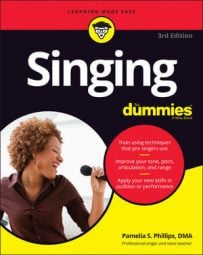The difference between the mezzo-soprano (or just mezzo) voice type and the soprano is often tessitura. (Tessitura refers to where most of the notes lie in a song — the notes that a voice feels most comfortable singing.) Many mezzos can sing as high as a soprano, but they can’t stay as high as a soprano.
For example, some roles in operatic literature require the mezzo to sing as high as the soprano lead, but the mezzo usually doesn’t have to sing as many high notes as a soprano does — thank goodness — because the mezzo comfort zone is usually different than the soprano; mezzos prefer to live in their middle voices.
On the other hand, a soprano hates to live in her middle voice, preferring to sing high notes and soar above the orchestra.
To further confuse you, many sopranos sing mezzo repertoire. How dare they! That’s not fair, but it’s a fact. As in other aspects of life, after the soprano becomes famous, she sings repertoire that she enjoys and that may be music written for somebody else, such as mezzos.
So just because a soprano sings a song doesn’t mean that it’s a soprano song. You have to look at the details, such as the range of the song, and decide whether that range fits your voice.
-
Range: The mezzo range is usually G below Middle C to a High B or High C. Many mezzos vocalize as high as a soprano but can’t handle the repetition of the upper notes.
-
Register: The register transitions for the mezzo usually occur at E or F (first space) just above Middle C, and the E or F (fifth line) one octave above that.
-
Strength: Mezzos have a strong middle voice.
-
Voice tone: The mezzo voice is usually darker or deeper than her soprano counterpart.
-
Weakness: A mezzo’s head voice is often her weakness.
-
Subdivisions: One subdivision of mezzo is contralto. Singers often mistakenly say that they are altos. Alto is the part listed in choral music, but the voice type is either mezzo or contralto. Less common than mezzos, contraltos can usually sing from F below Middle C to about an F (fifth line) below High C.
A contralto has a darker, richer color and is more at home in the lower part of her voice. Sometimes singers darken their voices intentionally to make themselves sound like contraltos.
The contralto may take her chest voice–dominated sound up to a G (second line) above Middle C and shift into head voice around the D (fourth line), an octave above Middle C. Examples of contraltos include Marian Anderson and Maureen Forrester.
Mezzo subdivisions in the classical world include light lyric coloratura, full lyric coloratura, light lyric, full lyric, and dramatic. The dramatic mezzo is similar to the dramatic soprano. To be fair to the sopranos, Dramatic mezzos sometimes sing roles written for the dramatic soprano. You go, girls!
-
Mezzo belter: A mezzo belter doesn’t belt as high as the soprano belter. She has a heavier chest voice and is more comfortable singing material that’s lower. Listen to these singers to hear the sounds of mezzo belters: Bea Arthur, Pearl Bailey, Kaye Ballard, Carol Burnett, Carol Channing, Angela Lansbury, Lorna Luft, and Leslie Uggams.
-
Common performance roles: The mezzo is often the mother, the witch, or the sleazy girl in town. Her roles include such fun ones as Miss Hannigan in Annie, Mrs. Potts in Beauty and The Beast, Carmen in the opera Carmen, Amneris in Aïda, and Aunt Eller in Oklahoma!
-
Naming names: Famous mezzos you may know include Karen Carpenter, Patsy Cline, Marilyn Horne, k. d. lang, and Lorrie Morgan.
 Mezzo range.
Mezzo range.

